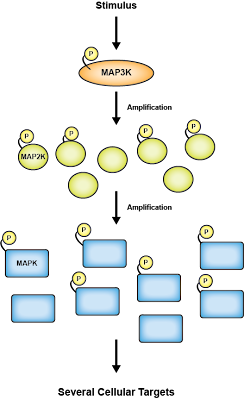First, MAPK signifies mitogen activated protein kinase - a fancy word for a protein that responds to mitogens, or a molecule that stimulates mitosis. Proteins of the MAPK family were discovered in 1989 in yeast, with ERK1 being the first mammalian MAPK signaling protein, involved in insulin signaling pathways (at the time at least...).
The MAPK signaling pathway is often called a cascade because the components in the pathway amplify a signal within the cell. The three major components are:
- MAPKKK / MEKK / MAP3K: The MAP kinase kinase kinase. This protein phosphorylates MAP kinase kinase. Several forms are found within the cell and their abundance is lower than that of MAPKK or MAPK; thus, MAPKKK isn't as involved in the amplification of signals.
- MAPKK / MEK / MAP2K: The MAP kinase kinase. MAPKK phosphorylates MAPK and is highly abundant within the cell, but its only substrate is MAPK. Just a few phosphorylation events on MAPKK result in significant activation of MAPK.
- MAPK / ERK: The MAP kinase. MAPK is also abundant in the cell and has diverse substrates, including itself.
There are several pathways that involve MAPK signaling. Two of the important ones are:
- The ERK pathway: growth factor stimulation of cell surface receptors (via receptor tyrosine kinases [RTKs]) causes activation of Ras, which activates Raf (MAPKKK) to activate MEK (MAPKK) and then ERK (MAPK). ERK's several targets include Elk and Ets, which control cellular proliferation.
- The JNK pathway: Stress on the cell results in activation of several proteins, including Rho, which goes on to activate MEKK, then MEK, and JNK. JNK's major targets include c-Jun, ATF2, and Elk1, which control proliferation and apoptosis.
One important consideration is the specificity of MAPK signaling. Specificity can be achieved in several manners: protein components can only "fit" other specific protein components. Additionally, the spacial organization of a cell can affect specificity, and this type of specificity is often controlled by scaffold proteins.
MAPK signaling is essential for many cellular processes, including proliferation, apoptosis, embryonic development, and cancer progression. Many intricacies of the pathways are still being worked out and will provide significant insight in the future.


No comments:
Post a Comment